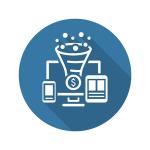How To Use Mobile Devices Effectively In Sales Meetings



Just like you would do at the movies, in church or another place where people are gathering for a collective activity, you turn off your smartphone. You don’t want to be the person who suddenly gets a loud call and draws unwanted attention to yourself. The same goes in a sales meeting.
By now, everyone knows the rules. Just like you would do at the movies, in church or another place where people are gathering for a collective activity, you turn off your smartphone, or at least its ringer. You don’t want to be the person who suddenly gets a loud call and draws unwanted attention to yourself. The same goes in a sales meeting.
In fact, the risks in sales meetings are even more acute because in some cases, they aren’t activities in which everyone involved really wants to participate. There can be boring parts of the meeting that have people itching to check their email, or alerts from clients that might seem more important than what’s being discussed. The general consensus has been to simply ensure sales meetings, like so many other gatherings, as smartphone-free.
The irony is that many of those same companies are trying to encourage their sales teams to make better use of their smartphones when they’re not in a meeting. This includes the use of business apps that can save time and boost productivity. If mobile technology is really so powerful, aren’t there any creative ways in which they could bring value to a sales meeting? The answer is yes. In fact, at least five come to mind:
1. Take The Pulse Of The Room
If you’ve gone to large business conferences, you may have seen organizers occasionally make use of polls to gather where attendees sit in terms of attacking a particular problem or issue. A few years ago these polls required sophisticated devices to be placed on tables, but now it’s often possible to send text messages to register a particular opinion.
Why not take this same approach and scale it down to the sales meeting? Even if your team only consists of a handful of people, it could be interesting to see how they respond to a particular question. Ask about morale over the previous week, for instance. See how they feel about the traction on a recently-introduced product or service. Or ask a fun question about how they’ll spend their weekend. The submissions can be anonymous, but they could help stimulate the kind of discussion that keeps teams more engaged than usual.
2. Dig Into Data
One of the longest-running challenges in many organizations is getting sales teams to use the applications they’re given. When insights from those apps are often presented, however, it’s done via PowerPoint, projected on a large screen. Having to turn and present to the points on a screen just gives many people an excuse to sneak looks at their smartphone instead.
Think about leaning into this behahaviour by having the team open their mobile CRM or analytics app to find the same information. The benefit of these tools is that they make insights collectively available, and by having people do the digital equivalent of turning to a particular piece of paper, you’ll be encouraging them to make checking in and updating the data more of a regular habit.
3. Study Social Media Together
If the idea of “social selling” still puts your team off, help them get over one of the most difficult steps, which is finding time to look on various platforms to see what customers and prospects are talking about. This could be a mini-workshop activity: have them choose a service, such as Twitter or LinkedIn, and give them a few minutes to check through status updates or conduct searches on hashtags and trending topics. Then go around the room to have each person report on something useful they saw and which they could act upon.
If this kind of exercise goes awry, don’t panic. Use it as an opportunity for on-the-spot training in how to navigate these channels, or to ask questions of the team if you’re not sure of something yourself. This could go a long way to making social selling more of reality in your company.
4. Conduct A Collective App Review
The decision to use a particular app for sales purposes often starts outside of the people doing the selling. That explains a lot of the time and energy involved in getting teams up to speed on such tools.
A sales meeting could, in fact, be a great opportunity to take a few minutes to have people try a potential app in a sort of intensive beta testing session. What do they like? What don’t they like? What does this tell you about the likelihood of adoption? There could be more information here to make a decision than you’d get in countless other, more traditional sales meetings.
5. Preserve Analog Brainstorming
White boards are great spaces to draw diagrams, take notes and doodle ideas for new products and services. The only trouble is they tend to get wiped off, which means so much of that ideation can be lost. Even those who take their own notes throughout are bound to forget something.
One of the most common uses for smartphones other than making calls, of course, is taking pictures. Leave time in your next group huddle to let people snap their own permanent record of what you discussed. Then let them take those smartphones out the door and do even more with them.
Get more sales tips to fuel your success in 2016 and beyond in Saleforce’s free eBook:























